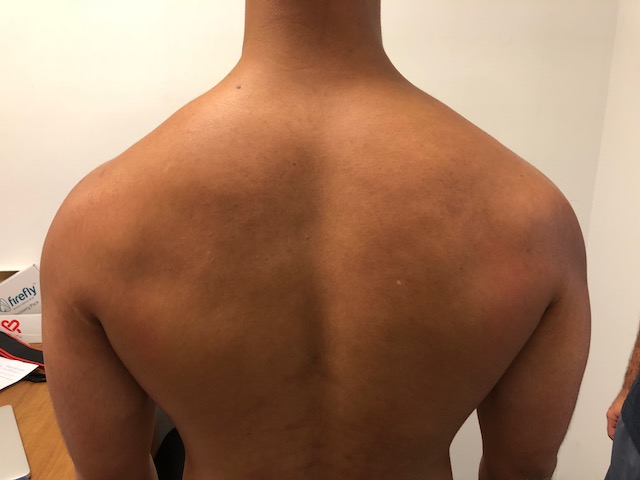
Case Study: Shutting Down Scapular Depression
Check out this little “challenge” I posted on Instagram. What do you see?
I see some of the lowest shoulders in history. This is a well-muscled guy who looks like his upper traps are non-existent because he sits in such significant scapular depression. Take note of the angle of his clavicles; normally, they should have an upslode from the sternoclavicular joint to the acromioclavicular joint, but in this case, they’re actually downsloped. Wherever the scapula goes, the collarbone follows. In this presentation, expect to see tissue density in lats, subclavius, and scalenes (among other areas).
The most interesting discussion point, though, is what to do about that upper trap tightness. That tightness is protective tension: his body doing anything it possibly can to avoid dropping any lower into scapular depression. The upper traps are working to elevate the scapula against gravity all the time. If you give him a bunch of massage and stretching, it’s like picking a scab; he’ll feel better for 15 minutes, and then in rougher shape over the long haul. You never want to stretch out protective tension.
He’d had previous bouts of unsuccessful physical therapy, and while I had the benefit of hindsight here, it was clear that the unifying theme of these approaches was an emphasis on the one-size-fits-all “pull the shoulder blades down” cue that gets thrown around all too much and usually leaves this presentation in a tough spot while helping a lot of senior citizen rotator cuff pain cases. You can’t one-size-fits-all cues because everyone moves differently.
We modified his training to avoid anything with heavy weights tugging the shoulders down (no deadlifts, walking lunges, farmer’s walks, etc.) and instead trained the lower body with lots of front squat and goblet set-ups, plus sled work, glute-ham raises, and barbell supine bridges/hip thrusts. We cut back on lat dominant upper body work and instead chose drills like push-up variations and landmine presses that drove scapular upward rotation (and even prioritized elevation, which is borderline heresy in some rehab circles). We got his arms overhead more often during the warm-ups and integrated some manual therapy in the areas I noted earlier. I even encouraged him to do less unsupported sitting at work, too, because his upper traps were competing against gravity all the time (yes, there are actually times that standing desks make things worse).
Today, two weeks to the day after the evaluation, he’s feeling significantly better – and training hard. Posture is the interaction of structure and function, and if you can’t identify aberrant postures, you’re simply guessing with how someone is going to respond to a given exercise.
Interested in learning more about what I look for when evaluating the upper extremity – and how my findings drive our programming and coaching cues? Check out Sturdy Shoulder Solutions (which is on sale for $40 off through Sunday at midnight with coupon code SPRING25) at www.SturdyShoulders.com.



